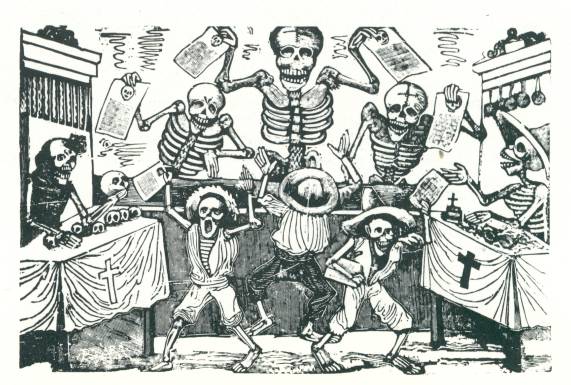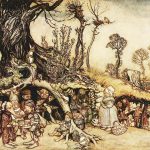In addition to maintaining as many citizens as possible “alive” , societies also honor their dead or invite them back for visits.
Days of the dead
Celts
The day before the new year was celebrated as Samhain, when God took over from the Lady to rule the earth. During this transition on November 1, the dead were allowed to come back to the earth and mingle with humans and celebrate.
Rome
On May 9, 11, and 15, the Romans “celebrated” the Lemuria to appease any lemures that might be haunting their houses. The head of the household would awake at midnight and make the sign of mano fico (a fertility charm) and walk barefoot while spitting out nine black beans as an exchange for the occupants of the household. Otherwise, the lemures might carry away any living person they choose.

Modern Europe and North America
- Halloween, October 31st. The dead are free to roam the Earth on this night. People dress up so the spirits will leave them alone.
- Day of the Dead, November 1st. Celebration of the memory of dead relatives
- All Souls Day, November 2nd. Souls of the faithful will be cleansed at this time if they haven’t been cleansed yet.
Mexico
In Mexico, the Days of the Dead (día de los muertos) celebration on the first and second of November also marks the return of dead spirits, which some see personified in migrating butterflies. Offerings are made to the deceased, and survivors visit grave sites, sitting on them in a celebration of life. Others set up altars at homes, decorating them in flowers. Places are set at the table for dead loved ones, and special pumpkin bread and bread of the dead (pan de muerto) is cooked. The country fills with bones and skulls, ranging from candy to skeletons dressed for specific professions. Children run through the streets shouting calaveras (skulls) for candy and money all add to the holiday
China
There is a festival called Zhongyuan Jie or Yulan Jie, on the 15th day of the seventh lunar month – that is Friday, August 23. According to legends and Chinese folklore, during the seventh lunar month, the gate of hell is wide open and all the spirits are let out to stay with their living families until the end of the month when they have to return to hell.
The festival is recognized in both Taoism and Buddhism, the two dominant religions in China. In both, this day is a time when the souls of the dead are redeemed.
The word Yulan means “liberation from suffering” in the original Sanskrit (ullambana), and Yulan Jie has its roots in the Buddhist story of Mu Lian, a disciple of Buddha, who saved his own mother.
It is said that Mu Lian (Maudgalyayana in Sanskrit), who gained magical powers on reaching a high level in knowledge of Buddhist doctrines, saw his mother starving in hell, with a huge belly and very small mouth, unable to swallow any food.
His mother had been a miserly woman and had not done a single charitable deed in her lifetime. She was condemned as a hungry ghost in the lowest depths of hell. Mu immediately fed his mother some rice, but the rice was reduced to ashes when it touched her mouth.
Mu begged Buddha for help, but Buddha said the mother had committed too many sins in her lifetime. The Buddha advised Mu to collect various types of fruit and vegetables in Yulan basins as an offering to the Buddhist monks. Only by doing this could his mother´s suffering be alleviated.
Local families used to place offerings for their ancestors – usually food, incense, candles and joss money – to be spent in the underworld. Future generations continue to put fruit and vegetables in Yulan basins as offerings to monks, and the festival turned into a time for remembrance of ancestors.
In many places of South China and Japan, people used to make paper boats on each of which a lit candle is placed. They would put these little lanterns into the river and let them float down the water. Children would try to follow the paths of their lanterns from the riverbank to see whose lantern could go the farthest.
One folk story said this custom is to send the lanterns as a guide for the spirits of their loved ones, to show them the road back home. Another tale said these lanterns are to send away the spirits of those who died of drowning. It is believed that these spirits, “drowned ghosts”, will suffer in the water until someone else comes to take their place.
It is thought that many people have died by drowning simply because they were pulled into the water by ghosts who were eager to find a substitute for their suffering. In a part of the spring festival called “saluting the tomb,” graves are covered in red rice and peeled eggs. Paper money is burned on behalf of the dead. During the winter, the Winter Dress Festival is also an occasion to visit ancestral graves. This time, they burn paper garments.
Panama City
During Carnival before Ash Wednesday, they throw a fish into the ocean in a mockery of funerals called the “Burial of the Sardine.” It is a symbolical burial of the past to allow society to be reborn, transformed and with new vigor.
Japan
People believe that all their ancestors’ souls visit their houses during “obon” days, which start on August 13th and last until 16th in most areas in Japan, so they prepare simple altars for the deceased and offer meals three times a day, fruits, and flowers in front of the altars. They visit the family grave firstly to bring their ancestors’ souls back to their houses, and secondly to see them off. People go home and feast all night, ending with ritual. Paper boats are put in water bodies with laterns, carrying away souls of the departed.
Northern Asian cultures share some similar traditions such as lighting lanterns and showing respect to their ancestors by visiting their graves.
India
Pitru Paksha also known as Shraddha, is a festival that is observed in Hindu faiths and is colloquially known as the ‘fortnight of the ancestors,’ Occuring in the Indian lunar month of Asvina – usually around September – it takes the form of ritualistic food offerings, and is subdivided into various observances, such as for those who have met an unexpected or violent death, those particularly close in relationship, and those who have passed away most recently. Abstinence, pure thoughts and pilgrimage are often observed during this time.








